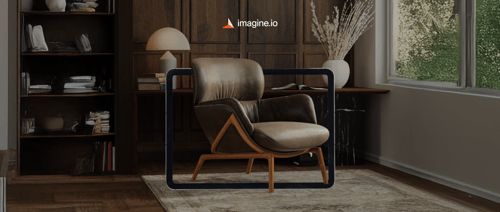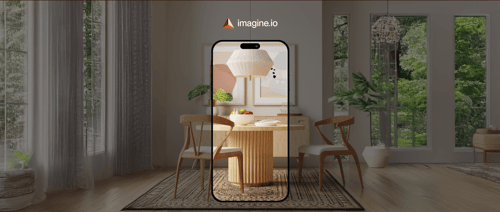3D visualization tools revolutionize online shopping by accurately communicating product dimensions and scale to customers. These technologies help buyers understand true product size.
Quick Listen:
Imagine you're shopping online for a new coffee table. The images are sleek, the price is right, but one question gnaws at you: will it fit in your living room? You hover over the dimensions 45 inches long, 24 inches wide but without seeing it in person, those numbers feel abstract. This moment of hesitation, where doubt creeps in, is where online retailers lose customers. Enter 3D visualization tools, a game-changing solution that's transforming how shoppers perceive product scale, boosting confidence, and driving sales in the fast-evolving world of eCommerce.
The Scale Problem in Online Shopping
In a physical store, you can circle a product, gauge its size against your own body, or even test how it fits in a space. Online, you're left with flat images and a list of measurements that might as well be hieroglyphs. This gap between digital displays and real-world scale creates what experts call “scale uncertainty” a psychological hurdle that leads to abandoned carts and eroded trust. Shoppers want to know: will that chair dwarf my room? Is that speaker truly portable? Without clear answers, they hesitate, and retailers pay the price.
Some industries face this challenge more than others. Furniture, where a misjudged sofa can dominate a space, is a prime example. Fashion and accessories also suffer think of a necklace that looks bold online but arrives as a delicate trinket. Consumer electronics, like tablets or headphones, often mislead when their size isn't clear, leading to returns and frustrated customers. Solving this problem isn't just about better photos; it's about reimagining how we convey scale in a digital world.
How 3D Visualization Solves the Scale Dilemma
The solution lies in 3D visualization, a technology that brings products to life with unprecedented clarity. One powerful approach is embedding reference objects in 3D models. Picture a virtual lamp displayed next to a standard coffee mug or a smartphone suddenly, its size becomes relatable. These familiar items anchor the viewer's perception, making abstract dimensions tangible without requiring a tape measure.
Augmented Reality (AR) takes this further with room-based previews. Shoppers can use their phone to “place” a product in their own space, seeing how a dining table fits in their kitchen or a rug complements their floor. Tools from platforms like imagine.io make this process seamless, turning product pages into immersive experiences. Meanwhile, 360° configurators allow customers to zoom, rotate, and explore products from every angle, offering a near-physical sense of scale that static images can't match.
These tools aren't just flashy they're effective. According to a market analysis by UnivDatos, the 3D eCommerce sector is expanding rapidly, with applications across industries like electronics, automotive, and even niche markets like biodegradable menstrual pads, where clear product type visualization is critical. By providing contextual scale, 3D tools are reshaping how consumers shop online.
Real-World Wins with 3D Visualization
The impact is measurable. A direct-to-consumer furniture brand saw returns plummet by 32% after implementing a 3D sofa configurator, allowing shoppers to visualize how pieces fit in their homes. In another case, an electronics company boosted portable speaker sales by embedding 3D models with a size comparison to a mobile phone, dispelling misconceptions about compactness. These examples show how 3D visualization translates into fewer returns, higher conversions, and happier customers.
Beyond furniture and electronics, industries like specialty retail are adopting 3D tools to clarify product scale. For instance, online channels for biodegradable menstrual pads benefit from clear visualizations that help customers understand product dimensions and suitability, as noted in the UnivDatos report. By addressing scale upfront, retailers are building trust and reducing post-purchase surprises.
The Hurdles of Adopting 3D Technology
Implementing 3D visualization isn't without challenges. Creating accurate 3D models demands precise CAD data or photogrammetry, which can be resource-intensive for retailers managing thousands of products. High-fidelity visuals also strain website performance shoppers won't tolerate slow load times, no matter how stunning the graphics. Device compatibility adds another layer of complexity, as 3D tools must work seamlessly across browsers and mobile devices to deliver a consistent experience.
Yet these obstacles are outweighed by the benefits. Accurate scale visualization reduces friction, encouraging shoppers to complete purchases with confidence. It also curbs returns, a costly problem for retailers, by setting clear expectations. Interactive 3D models keep visitors engaged longer, increasing dwell time and boosting conversion rates. For eCommerce leaders, the investment in 3D technology is proving to be a strategic necessity.
The Future of Scale Visualization
The horizon is bright for 3D visualization. Artificial Intelligence is poised to enhance these tools further, with features like auto-scale tagging that dynamically adjusts indicators like virtual rulers as shoppers interact with models. WebAR is also gaining momentum, allowing seamless AR integration directly into product pages without app downloads. For retailers, the focus is clear: prioritize scalable, efficient 3D solutions that balance user experience with operational feasibility.
As these technologies evolve, they're not just solving scale uncertainty they're redefining the online shopping experience. Retailers who embrace 3D visualization are positioning themselves as leaders in a competitive market, offering customers the clarity and confidence they crave.
A Vision for Confident Shopping
In the digital age, where every click is a leap of faith, conveying a product's true scale is no longer optional it's essential. Platforms like imagine.io are at the forefront, empowering retailers to bridge the gap between virtual and physical with tools that make products feel real. By eliminating guesswork, 3D visualization builds trust, reduces returns, and creates shopping experiences that are as intuitive as they are engaging. The next time you're browsing for that perfect coffee table, don't settle for flat images. Demand a 3D view, spin it around, and see it in your space. The future of online shopping isn't just about buying it's about knowing, with certainty, that what you see is what you'll get.
Frequently Asked Questions
How do 3D visualization tools help solve the scale problem in online shopping?
3D visualization tools address "scale uncertainty" by providing interactive experiences that make product dimensions tangible and relatable. They use techniques like embedding reference objects (coffee mugs, smartphones) in 3D models, offering 360° configurators for detailed exploration, and enabling AR room-based previews where customers can virtually place products in their actual spaces. This eliminates the guesswork that leads to cart abandonment and returns.
Which industries benefit most from 3D product visualization for scale accuracy?
Furniture retailers see the biggest impact, as misjudged sofas and tables can dominate living spaces, leading to costly returns. Fashion and accessories also benefit significantly, helping customers understand if jewelry will appear bold or delicate in person. Consumer electronics companies use 3D tools to clarify portable device sizes, while specialty retail sectors like biodegradable menstrual pads leverage clear visualizations to help customers understand product dimensions and suitability.
What measurable results can retailers expect from implementing 3D visualization tools?
Retailers implementing 3D visualization see substantial improvements in key metrics. A furniture brand reduced returns by 32% after adding a 3D sofa configurator, while electronics companies boosted portable speaker sales by using size comparisons with familiar objects like mobile phones. Beyond reducing returns, 3D tools increase customer dwell time, improve conversion rates, and build trust by setting clear expectations before purchase.
Disclaimer: The above helpful resources content contains personal opinions and experiences. The information provided is for general knowledge and does not constitute professional advice.
You may also be interested in: 3D Solutions for New Product Development - imagine.io
Struggling with expensive, outdated product visuals that slow down your creative process and stunt eCommerce growth? imagine.io's AI-powered platform empowers furniture, home décor, and textile brands to effortlessly produce striking 3D images, immersive videos, AR experiences, and interactive configurators. Cut production costs up to 70%, boost conversions 5X, speed up prototyping, and supercharge your online sales. Ready to elevate your product visuals and captivate customers? Book a demo with imagine.io today!
Powered by flareAI.co




.png?width=500&name=How%20to%20Add%20a%203D%20Product%20Configurator%20to%20Your%20WordPress%20Website%20(Complete%20B2B%20Guide).png)
















%20(1).png?width=500&name=Why%20Exploded%20Mattress%20Views%20Matter%20(And%20How%20to%20Generate%20Them)%20(1).png)
.png?width=500&name=Best%20Shopify%20Product%20Configurator_%20How%20to%20Choose%20the%20Right%20One%20(2).png)
.png?width=500&name=Why%20Exploded%20Mattress%20Views%20Matter%20(And%20How%20to%20Generate%20Them).png)



.png?width=500&name=Best%20Shopify%20Product%20Configurator_%20How%20to%20Choose%20the%20Right%20One%20(1).png)







.png?width=500&name=How%203D%20Rendering%20Can%20Make%20or%20Break%20Your%20Industrial%20Design%20Pitch%20(1).png)








%20with%20Digital%20Twins%20and%203D%20Visualization.png?width=500&name=Optimizing%20Your%20Digital%20Asset%20Management%20(DAM)%20with%20Digital%20Twins%20and%203D%20Visualization.png)




.png?width=500&name=Styling%20Home%20Decor%20for%202025_%20From%20Global%20Influences%20to%20Playful%20Personalization%20(1).png)
